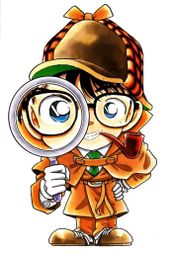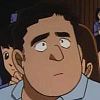Difference between revisions of "Recurring Tropes"
(Important characters for serious plots tend to be attractive/cool and younger, not quirky or middle-aged) |
(spoiler box) |
||
| Line 36: | Line 36: | ||
Most plot important characters, even adults, tend to be young, 30s or lower. Most of the main recurring police have not left their twenties. There are many exceptions as this general trend. | Most plot important characters, even adults, tend to be young, 30s or lower. Most of the main recurring police have not left their twenties. There are many exceptions as this general trend. | ||
| − | + | ====A selection of people who are relevant and irrelevant, with distinct differences in appearance==== | |
| + | <spoiler> | ||
[[File:Subaru Okiya.jpg|100px]][[File:Kansuke Yamato.jpg|100px]][[File:Vermouth.jpg|100px]][[File:Eisuke Hondou.jpg|100px]][[File:Masumi Sera.jpg|100px]][[File:James Black.jpg|100px]][[File:Ai Haibara.jpg|100px]][[File:Hyoue Kuroda.jpg|100px]][[File:Tomoaki Araide.jpg|100px]][[File:Shukichi Haneda.jpg|100px]] | [[File:Subaru Okiya.jpg|100px]][[File:Kansuke Yamato.jpg|100px]][[File:Vermouth.jpg|100px]][[File:Eisuke Hondou.jpg|100px]][[File:Masumi Sera.jpg|100px]][[File:James Black.jpg|100px]][[File:Ai Haibara.jpg|100px]][[File:Hyoue Kuroda.jpg|100px]][[File:Tomoaki Araide.jpg|100px]][[File:Shukichi Haneda.jpg|100px]] | ||
| − | |||
| − | |||
[[File:Reiji Fukuura.jpg|100px]][[File:Shishihiko Tarumi.jpg|100px]][[File:Mari Idenami.jpg|100px]][[File:Nakamichi.jpg|100px]][[File:Ayako Ninagawa manga.jpg|100px]][[File:Toshimitsu Tsujimura.jpg|100px]][[File:Toji Funemoto.jpg|100px]][[File:Sakae Furuya.jpg|100px]][[File:Mai Kogami.jpg|100px]][[File:Yota Mitani.jpg|100px]] | [[File:Reiji Fukuura.jpg|100px]][[File:Shishihiko Tarumi.jpg|100px]][[File:Mari Idenami.jpg|100px]][[File:Nakamichi.jpg|100px]][[File:Ayako Ninagawa manga.jpg|100px]][[File:Toshimitsu Tsujimura.jpg|100px]][[File:Toji Funemoto.jpg|100px]][[File:Sakae Furuya.jpg|100px]][[File:Mai Kogami.jpg|100px]][[File:Yota Mitani.jpg|100px]] | ||
| + | </spoiler> | ||
== Regular Mystery == | == Regular Mystery == | ||
Revision as of 16:21, 25 May 2016

|
This page is currently being edited. Please consider helping the users to complete the page and fill in the missing pieces if you are able. |
| Meta Topics |
|---|
 |
| A Doylist perspective on Detective Conan |
| In-Universe Laws |
| Canon |
| Internal rules |
| » Disguise |
| Mistakes and changes |
| Oversights in Detective Conan |
| Differences between the manga and anime |
| Differences between magazine and volume |
| Recurring Patterns |
| Tropes |
| General |
| Setting and recurring locations |
| » Real life models for settings |
| List of timelines |
| In-universe culture |
| Continuity |
| Crossover |
| The Fandom |
| Fanon |
| Fan theories |
All authors, including Gosho, have certain styles and tropes they recycle in their writing. Specific examples of tropes that contain spoilers should be put in a spoiler box.
Contents
- 1 Mystery Related Tropes
- 1.1 General
- 1.2 Regular Mystery
- 1.3 Kaitou Kid Heist
- 1.4 Arc Mystery
- 2 Romance Related Tropes
Mystery Related Tropes
Foreknowledge of Gosho's preferred tropes and method of building mysteries gives a reader a significant advantage is solving them.
General
Lack of recurring character death
No recurring character --one who has appeared in person alive for more than one case-- has been killed as of chapter 925. Any recurring characters who have died did so in their first case and reappeared in flashblacks, were stated to be dead from the outset, or faked their death.
Lack of information sharing
There have been many situations where allied characters know information that would be extremely helpful to the others and would prevent unfortunate situations, but the characters keep it to themselves. This often catches many readers unfamiliar with Gosho's style off guard because they assume that the intelligent characters would exercise common sense and try to work together effectively. One of Gosho's favorite ways of creating conflict and crisis is by having characters withhold crucial information from the one who needs it which then leads to a negative consequence. Pragmatically, it means that the reader cannot assume one character has told his teammates about a major event or obvious threat unless explicitly told they shared information. Similarly, the reader cannot expect characters to become more open to sharing even after experiencing a negative consequence. This applies mostly to arc mysteries, but occasionally appears when there are two or more detectives working on a single case.
The lack of information sharing also applies to the antagonists. The Black Organization often fails to share information among its ranks. Sometimes the information sharing that takes place seems especially arbitrary.
Plot progresses by coincidental encounters instead of chasing leads
Gosho often progresses through plots with a series of coincidental encounters, situations where Conan happens to be in the right time and place to find a case or something plot relevant. Conan doesn't spend a lot of time chasing down leads and finding dead ends until one of them pans out. Plot relevant people are also likely to coincidentally appear by chance in cases.
Important characters for serious plots tend to be attractive/cool and younger, not quirky or middle-aged
Important plot characters used for serious storylines tend to be cool or attractive and have more individualized, detailed, and careful designs than the usual suspects which often have appearance quirks such as oddly shaped heads, pronounced teeth, enlarged noses or lips, etc. Characters become less detailed the less often they reoccur, or were originally anticipated to reoccur. Gosho has acknowledged this general principle in at least one interview question.
Q:先生が漫画を描く上で大事なさっていることは?
When sensei draws manga, what do you value?
A:男の子はかっこよく、女の子は可愛くですね。最近は蘭や世良などの女の子もかっこよくなってきちゃいましたけどね(笑)。
To draw cool boys and cute girls. Though Ran and Sera and such girls are becoming cooler these days (laughs).
Most plot important characters, even adults, tend to be young, 30s or lower. Most of the main recurring police have not left their twenties. There are many exceptions as this general trend.
A selection of people who are relevant and irrelevant, with distinct differences in appearance
Regular Mystery
Most regular cases (with the first cases being much more variable) are 3-6 chapters long, with the last chapter dedicated to the solution.
Most cases are murder cases
About three out every four cases involve a murder.[1]
Murder motives are usually personal
The vast majority of murder motives are usually personal (e.g. a grudge) or to silence a witness. That said, there have been isolated incidences of accidents, would-be-spree murderers, and attempted professional assassination.
Kaitou Kid Heist
So far Kaitou Kid has not repeated a main disguise in the Detective Conan manga where a significant portion of the case was dedicated to guessing who he was disguised as. Incidental disguises may be repeated. His disguises so far are kept up to date at List of Kaitou Kid disguises. The major ones where he used a recurring character are:
- Ran: Conan vs. Kaitou Kid
- Kogoro: The Gathering of the Detectives! Shinichi Kudo vs. Kaitou Kid
- Jirokichi Kaitou Kid's Miraculous Midair Walk
- Takagi: Kaitou Kid and the Four Masterpieces
- Nakamori: The Kirin's Horn That Vanished into the Dark
- Genta: The Kirin's Horn That Vanished into the Dark
- Masumi: Kaitou Kid and the Blush Mermaid
- Sonoko: Kaitou Kid VS Makoto Kyogoku
Arc Mystery
An arc mystery usually takes the form of identifying the true allegiances of various mysterious characters that appear over the course of 100-300 chapters. So far they have all started with the introduction of a codenamed Black Organization agent and ended with a clash related to that agent where various allegiances and backstories are revealed. The main arc mysteries so far are the Vermouth arc, the Kir arc, the Bourbon and Akai arc, and the Rum arc. There are several tropes that apply especially to this long mystery subtype.
In arc mysteries, clues are released so that the mystery becomes easier to solve towards the end of the arc. Clues towards the beginning are often better hidden and require more analysis to interpret correctly. More overt clues and bits of backstory that provide hints appear with increasing frequency nearer to the end of the arc.
Arc suspects include protagonists and antagonists
Arc mysteries usually involve at least one Black Organization member and several other characters who are suspicious but who oppose the Black Organization in some form.
Overly suspicious often equals red herring
Overly suspicious characters are often red herrings on the side of good, while seemingly innocuous characters are more likely to be the opponent. Suspicious protagonist characters prior to their allegiance reveal are often shown lurking and watching from the shadows, asking prying questions, and saying vague mysterious quotes that could be taken as threats. Innocuous antagonists are not shown lurking as often or asking as many questions. Towards the end of an arc, antagonists may begin to act slightly more suspiciously. This coincides with clues becoming easier to identify and interpret.
Lots of spies
Most of the arc mystery suspects who turn out to be protagonists are spies.
Furthermore in every arc, at least one spy in the Black Organization was revealed.
Enemies rarely uncover secret identities
Characters who appear to be approaching Conan's or Haibara's true identity are unlikely to be enemies in the end.
Haibara is a sentinel for Black Organization members
Haibara has stated outright that any Black Organization member that recognizes her as a child would surely make it first priority to find out where she lives and attack.[2] Conan has also used similar reasoning to deduce that someone who interacted with Haibara probably isn't a Black Organization member.
This information strongly implies that any character who has closely interacted with Ai Haibara cannot be a Black Organization member who both recognizes Shiho as a child and is loyal and without ulterior motive. This rule of thumb has proven useful for ruling out arc mystery suspects who approach Haibara closely at some point.
Misleading dialogue
Gosho frequently manipulates the reader's sense of suspicion with dialogue that sounds mysterious and threatening, or is misleading without the appropriate context. The technique works well because dialogue is pliable; it is easier to create deceptive dialogue than it is to create deceptive action. Gosho also uses especially shocking or quotable lines towards the end of cases to distract from other more useful clues that might have appeared.
Quotes intended to mislead are relatively easy to identify.
- They often sound poetic.
- They are vague, forcing the reader to make assumptions about the speaker, the subject, or what they are referring to. The goal is to trick the reader into filling in the blanks using the immediate context instead of the true context.
- Sometimes no one is specifically named in the quote, but someone is alluded to via terms like "that person".
- When only one half of a two-sided conversation is shown there may be an attempt to trick the reader into assuming the other half is someone else.
- They often take the form of a monologue or character thought.
- They sound mysterious or threatening.
These sorts of trap quotes are perhaps best countered by simply ignoring them and focusing on other evidence. With a few exceptions, mysterious lines are rarely helpful in figuring out people's allegiances, especially since the actual context of the quote may not be revealed for some time. A character's actions always speak louder than their words.
Romance Related Tropes
Childhood friends become adult romances
True breakups in the main cast are rare
- Current main cast breakups only include Shuichi Akai/Jodie Starling.
Breakups are fixed when the same couple gets back together
- Separations such as Kogoro Mouri/Eri Kisaki and Yumi Miyamoto/Shukichi Haneda are both in the process of being fixed because both people still find the other attractive.
References
- ^ http://forums.dctp.ws/viewtopic.php?f=5&t=3518&start=990#p862055
- ^ Paraphrase of a conversation between Ai and Conan when they decide that Hyoue Kuroda probably isn't Rum because he hasn't attacked Agasa's house yet.
- ^ Manga Volume 32, File 10, page 18: "A Stupid Plan"





















